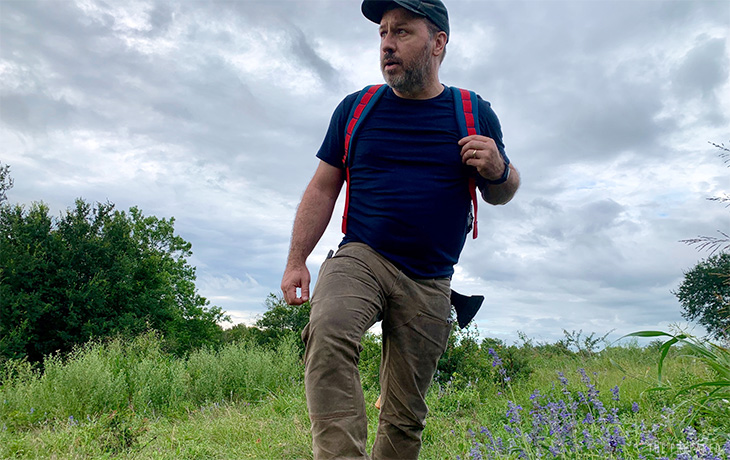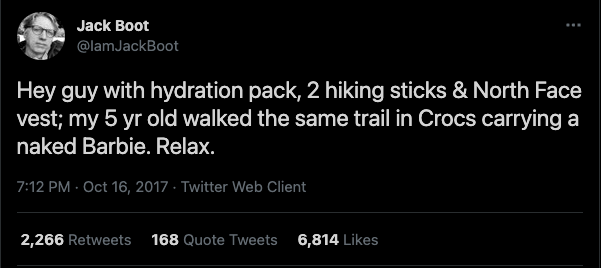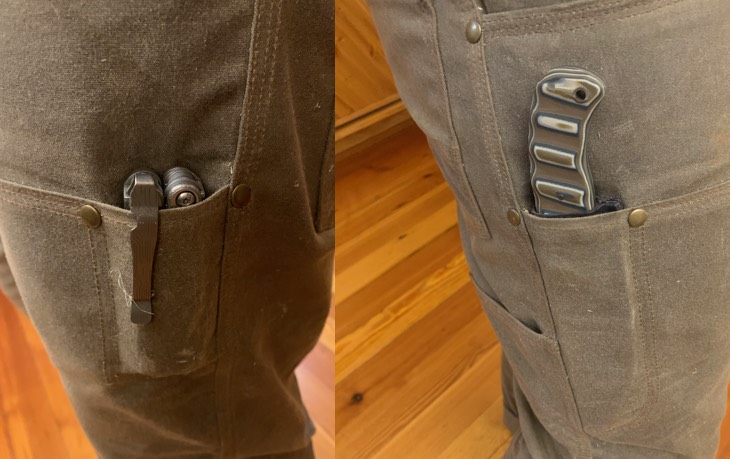Some people think of their normal-life clothing and “prepper clothing” as separate, keeping the latter in storage until an emergency hits. But hopefully this guide influences your daily wardrobe, too.
Not only could the right clothing make the difference between life or death, but changing the way you think about clothing (eg. function over fashion) can change the way you approach and enjoy daily life. Take the best-on-earth school system in Scandinavia, for example. A big part of their education is frequently getting kids outside. Rather than using their consistently-poor weather as an excuse and creating that kind of “victim mentality” in their kids, Scandinavians instead teach their children the cultural value “there’s no such thing as bad weather — only bad clothing!”
Knowing they’re wearing ultra-durable clothing often helps people feel more confident and be more active in their life. It’s that same “I can’t control the outside world, but I can control how I approach it” mentality taught to Scandinavian kids. And there’s something freeing when you care less about what other people think you look like and care more about your own happiness and potential.
Thankfully, the market is evolving to the point where, even if you’re a professional office worker, there are options that look appropriate yet are much more durable and functional than standard fare. Gone are the days where “technical pants” meant dorky zip-off legs and bulky cargo pockets.
Another benefit is that much of today’s common fashion, such as H&M and Old Navy (officially called “fast fashion” in the industry), is cheap crap meant to be thrown out in a few years when the styles change. Yet many of us would rather have timeless clothing we can use for years (even decades), especially after the zombies take over.
Summary:
- Don’t just think about the clothes in your go-bag. Try to improve your normal wardrobe, too.
- You often face a trilemma: lightweight, durable, inexpensive — pick any two.
- Clothing is a category where you get what you pay for. Be prepared to “buy once, cry once” and pay for good clothing that will last multiple years of hard use. Better to spend $200 once than $50 four times.
- If you’re on a tight budget, it’s almost always better to save up than to buy something $20 cheaper from Walmart.
- Focus more on materials and construction/design and less on brands/stores. The more boutique stuff is often better, anyway.
- For materials, prefer wool to cotton, and nylon to polyester.
- Avoid cotton for anything that will contact your skin, unless it’s a hybrid blend specifically known to fix cotton’s normal problems with absorbing too much water/sweat.
- Most clothes fail around the joints and edges. Look for reinforced seams, extra stitching, extra or tougher material at abrasion points, etc.
- Avoid tunnel vision when considering a specific garment. Keep in mind how it might layer with other clothing, mix and match, etc.
- The best options are easy to wash and repair with limited resources. Not only is this great in a long-term emergency, but you’ll save money and be less wasteful over the long run, too.
- For high-quality survival clothing that doesn’t flag you as “prepper”, look to the following categories: urban cyclist wear, workwear (including duty and tactical wear), techwear, and boutique heritage brands.
Focus on materials, construction, and style category
If you find yourself in a survival situation, you want clothing that is:
- Durable
- Light weight
- Protects you from the elements (eg. heat, cold, water, fire) or threats (eg. bugs)
- Easy to wash, maintain, and repair in the field
- Able to keep a low profile / doesn’t cause you to stick out
You’re not going to find all of these in any one article of clothing, and in fact it will be hard to get two or three of the above at the same time. You’ll have to make compromises to find prepper clothing that works for your goals and budget.
The above list of important qualities can actually be reduced further to just three: durability, weight, and cost. Everything above really falls under one of these three, and you’ll almost always be forced to pick just two of these at most when selecting any one item.
As you go shopping, the best way to meet these goals is by paying attention to materials, construction, and overall styling. Materials and build quality obviously affect things like durability, breathability, water resistance, UV protection, repairability, and so on. Styling is not about fashion, but moreso the category of clothing or kinds of stores to browse (eg. shop from REI before wasting time at Old Navy).
Clothing materials
The most fundamental division in fabrics is between natural fibers and synthetic fibers. Fabrics made from natural fibers tend to have the following benefits: ease of field repair, low cost, breathability, and moisture wicking. Moisture, though, is the enemy of most natural fibers.
Synthetics like nylon, polyester, and polypropylene shine in terms of strength-to-weight ratio, durability, abrasion resistance, and low cost. But they are often hard (or impossible) to field repair in a durable manner, and their main enemy is fire.
Natural/synthetic blends can give you the best (or worst) of both worlds, depending on the blend. For instance, nylon/cotton blends look, feel, and breath like cotton, but they’re much tougher; they’re also more dangerous around fire, depending on the amount of nylon content.
There are too many materials to list each specific type here. But the four most common and popular that preppers should know about are cotton, wool, nylon, and polyester. These are the basic fabric options for high quality survival clothing, and form the baseline against which all other fabrics are compared.
Cotton
- Main characteristics: Strong, inexpensive, breathable, highly absorbent, comfortable.
- Outerwear: Can be amazing in the right weave or blend, especially with the right finish and/or a cheap rain barrier worn over it.
- Base layers: Dangerous, because it will absorb sweat and hold it close to your skin, leeching your body heat. Do not use in this role.
- Versus water: Very absorbent, but, again, the right weave or finish can help.
- Versus fire: Safe to wear around open flame, though not exactly fire resistant.
“Cotton kills” or “cotton is rotten” is probably the most commonly-known concept in survival clothing. Yet, like most social media tropes, this is only partially true. Some cotton weaves, like Gabardine and duck canvas, can actually shed quite a bit of water before starting to soak. There are also cotton finishes — everything from modern durable water repellents (DWR), to old-school waxes and oils — that will add water repellency to cotton and cotton blends.
More: Why waxed cotton canvas is a great option for prepper outerwear
Then there are cotton blends, like the nylon/cotton blend (NYCO) used in the famous M65 field jacket. These blends can provide a fantastic mix of strength, durability, and low cost, especially when finished with a coating (factory applied or aftermarket) that helps keep the water off.
And as far as waterproofing goes, a cheap poncho or a garbage bag with head- and arm-holes in it can instantly make any cotton garment “waterproof.” So don’t overlook these little tricks.
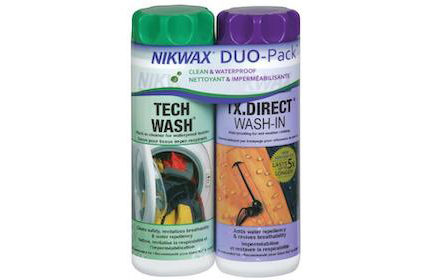
Nikwax Waterproofing and Cleaning
The main place where you have to be careful of cotton is when using it for base layers. Cotton as a base layer is always bad. Just don’t do it for underwear, socks, or anything else that sits next to your skin. You don’t want cotton to trap the moisture next to your skin and remove body heat.
Wool
- Main characteristics: Traps warmth even when wet, antibacterial, odor resistant, naturally flame retardant, comfortable, some moisture wicking, moderately strong but weak vs. abrasion.
- Outerwear: Wool outerwear is an old-school winter staple favored by many survival experts. The only real drawback in this role is the material’s low abrasion resistance. So wear spots will develop more quickly than with other fabrics.
- Base layers: Excellent choice in this role, because of moisture wicking and temperature regulation properties. Can feel itchy to some, though.
- Versus water: It absorbs some moisture and traps it close to the core of the fiber, which keeps it off your skin. It also has natural waxes that help it shed some water.
- Versus fire: Very safe to wear around open flame. Wool will turn safely to ash when burned, and it stops burning when the heat source is removed.
Wool is probably the best natural fiber for prepper clothing because it combines so many of the essential qualities at every layer, from base layers up to outerwear. A good wool garment will insulate you from the cold even when it’s wet. It will also shed snow and some amount of water before starting to soak. As a base layer, wool will wick moisture, then release it via evaporation when the temperature warms up, thereby helping you regulate your body temperature.
More: The wonders of wool/nylon blends for prepping
The main downsides to wool are high price and low abrasion resistance. Good wool products cost quite a bit more than cotton and synthetics, so be prepared to shell out. It’s also the case that finer wools, like Merino, have lower abrasion resistance and will pill or thin out from normal wear.
Nylon
- Main characteristics: Strong, lightweight, abrasion resistant, inexpensive, absorbs some moisture, stretches, melts easily and dangerously when exposed to extreme heat or open flame.
- Outerwear: Nylon is one of the very best prepper outerwear fabrics by every measure except flame resistance.
- Base layers: Nylon makes a solid base layer, unless you’re around a fire.
- Versus water: It has to be finished or coated to add water repellency.
- Versus fire: There’s a reason firefighters refer to synthetic base layers as “shrink wrap.” Like most synthetics, burning nylon will melt and cause serious injury, so you have to keep it away from open flame.
Nylon is extremely popular in outdoor and military clothing. It’s a more expensive synthetic than its main competition, polyester, but with a better strength-to-weight ratio and more abrasion resistance.
A high-quality, properly treated piece of nylon outerwear is as close to the very pinnacle of comfort, strength, and durability as you can get. But the material has two big downsides, and they are quite serious:
- Hard to repair: Your best repair option for nylon is really tape of some sort. It just doesn’t take as well to field stitching. The ripstop variant of nylon can often be sewn, but plain nylon really just needs tape or some kind of synthetic sealant.
- Melts when heated: When heated too much, nylon melts to your skin and leaves you with nasty burns.
If you can find ways to work around nylon’s problems in your preps, it’s really hard to beat. A common strategy is to carry some very lightweight nylon outerwear in a go-bag as a backup/alternative to the heavier wool or waxed canvas outerwear.
Polyester
- Main characteristics: Moderately strong, lightweight, inexpensive, doesn’t absorb moisture, non-stretch, burns easily and dangerously when exposed to extreme heat or open flame.
- Outerwear: Polyester makes a solid, less expensive nylon alternative in this role.
- Base layers: Polyester base layers are often quite comfortable and inexpensive.
- Versus water: Polyester doesn’t absorb moisture like nylon does, so it works well against rain and snow.
- Versus fire: Polyester sputters, melts, and gives off black smoke as it burns. You don’t want to be wearing it if that happens.
Polyester is much cheaper than nylon. And for some types of clothing applications, it’s actually better. It resists UV light and holds color a bit better than nylon, and there are some applications where you really don’t want the fabric to stretch out permanently in the way nylon can.
Learn more about different types of fabrics and textiles in the tarp review.
Fabrics made from polyester have pretty much the same downsides as those made from nylon, but with the added issue of lower abrasion resistance.
Functional design and construction quality
The right fabric is one thing, but it has to be put together in a way that will stand up to hard field use while still being comfortable and usable. Construction qualities such as double- or triple-stitched seams and reinforcements at key stress points, as well as thoughtful design touches that show a manufacturer has an actual sense of pride, are two of the easiest ways to tell different ‘tiers’ of products apart in the clothing market.
Put simply for American buyers: Clothing under $50 almost never leaves enough profit margin for companies to justify spending money on things like good zippers and stitching.
Sometimes clothing reinforcements are bits of nylon or other sturdy material sewn into seams or joins. Other times they use rivets in place of stitches. And still other reinforcements involve doubling up on material at places on the garment that take abuse, namely the elbows, legs, and crotch.
You’ll also want to visually inspect for tight, consistent stitching. Stitching that looks visibly sloppy in spots is sort of like the proverbial rat under the lamppost — there’s probably many more such flaws in places where you can’t see them.
Are there flashy and pointless features that are mostly there to fill out a marketing list? (“Boss, we can market this to preppers if we put a compass on it!”) Or can you tell that the people designing the product actually use it and understand the features that actually matter.
A practical example of all of the above are the GN Waxed Canvas Pants from Red Clouds Collective (pictured nearby). These pants feature triple-stitched seams, rivets, and double reinforced fronts. These pants simply won’t come apart before their time.
There are also two features that we really loved in our testing: an added pocket on the left leg that’s perfectly sized for a multitool, and a matching pocket on the right leg that’s sized and shaped to fit a fixed-blade knife.
Clothing categories: technical, tactical, duty, etc
There really is no such thing as “survival clothing” as a major retail category. And there doesn’t need to be — you just look at other styles/categories that focus on the same goals. It makes sense that clothing for mountain climbers will focus on weight and layering, for example, while clothing for cops is going to focus on durability and all-day wear.
Use this advice when browsing through general stores like Amazon, or better yet, go support your local ski/running/camping/whatever store that focuses on these niches. The people who work there are often knowledgable.
Tactical and outdoor clothing are the two most common niches worn by preppers. But they’re definitely not the only two options, or even the best. Other options include cyclist clothes, motorcycle wear, workwear, and techwear.
Outdoor wear
Outdoor clothing falls into two main buckets:
- The kind of camping, hiking, and climbing stuff you’d find at REI
- Hunting and fishing stuff sold at Bass Pro Shops
There’s a lot of overlap between these two categories in terms of materials, construction, quality, and price, so the choice between them often comes down to style. You can get away with the hiking clothes in an urban setting, while a rural setting is more friendly to hunting clothing choices.
There’s also a little bit of difference in the two categories in terms of where they fall on the weight vs. durability spectrum. Hunting clothing tends to be a little heavier and more robust, while hiking clothes are lighter yet a bit more fragile. Hunting clothing is often more limited for women.
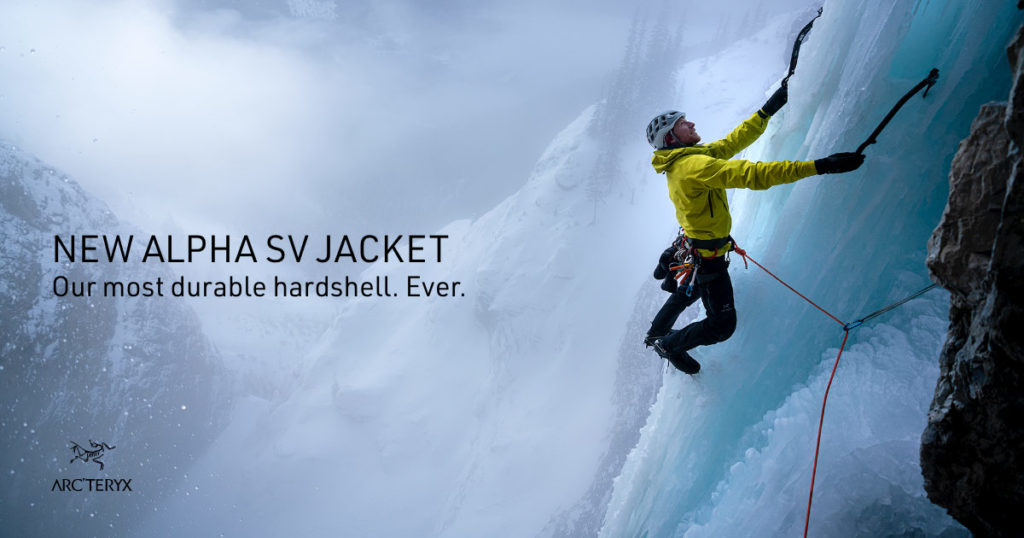
Both categories feature a market that’s stratified into tiers of price and quality. If you go downmarket, you can find great deals and values. But the cheaper outdoor brands are designed to last a season or two, then be thrown out. If you can afford it, you really want to go upmarket from that stuff and get gear that’s built to last multiple seasons of use and abuse. Many of the above-average brands have meaningful lifetime warranties, too.
If and when you do go upmarket, you’re fortunate to live in a kind of golden age of outdoor clothing. There are a number of brands for dedicated outdoor enthusiasts that have not sacrificed quality to chase outsized returns. Many of these are now highly sought after on the fashion scene, which means you can find them lightly used (once the trends move on) on resale sights like Grailed and eBay.
Some key outdoor clothing brands:
- Arc’teryx: Ultra-premium outdoor wear with outstanding construction and modern fabrics. Very expensive, but worth it if you can afford it. Anecdotally, some US Special Forces who get to pick out their own gear swear by this brand.
- Patagonia: High-quality outdoorwear with a conscience. Sourced variously, but quality control is strict.
- Salomon boots: Another storied favorite of operators and serious adventurers. Popular now in some fashion circles, but the quality hasn’t slipped.
Some key hunting clothing brands:
- Cabela’s: Upmarket from Bass Pro, who they’ve now merged with. Their house brands are good, and you can find higher end brands like Filson on the floor of many stores.
- Filson: On outdoors/workwear heritage brand that has seen its ups and downs. It took a dip after a private equity buyout when they started off-shoring, but they’ve since brought some production back to the US. You can get good clothes there, but be prepared to pay.
- Orvis: A sort of stuffy, high-end outfitter that appeals mainly to the fly fishing set. But they carry great brands like Barbour, and their house brand is also solid.
Tactical clothing
Intended for military and law enforcement, “tactical clothing” is essentially a very specific niche of the “workwear” category. This means it’s purpose-built, with a focus on quality and price so that it appeals to people who’ll be wearing it for their day job.
If you can pull off the tactical look without painting a giant sign on yourself that says “I HAVE PREPS, SO ROB ME FIRST,” then this category provides probably the best performance per dollar out of any of them.
Tactical clothes feature a lot of ripstop nylon (nylon fabric with a grid of threads sewn into it that can stop rips and allow some field repair), velcro, and similarly modern materials.
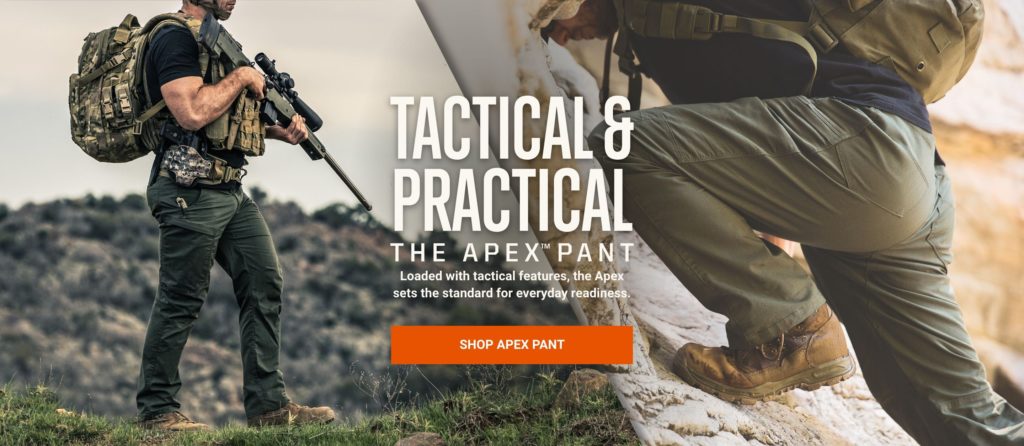
Often there are a lot of pockets in different places, along with D-rings, ties, and zippers. There may be ways to configure the garment differently, such as cinching up the bottoms of pants legs above the boots, securing a flashlight inside a pocket with a carabiner and a D-ring, or venting via zippered or velcro ports in a garment.
Again, all of this stuff will make you stick out like a Tactical Timmy in most environments, which is not necessarily the kind of attention you want drawn to yourself in a bad situation.
Tactical clothing tends to be quite comfortable and adaptable, which is a big reason why it can show up in the wardrobes of people who don’t otherwise care too much about guns or military gear. They just like the utility of it, and don’t really care how they come off.
Most tactical clothing has been aimed at men, but the big brands increasingly have women’s options.
Some key tactical clothing brands:
- Crye Precision: This is the Gucci of tactical clothing, a favorite of everyone from weekend airsofters to real operators. Very expensive, but “Crye or Die” is a saying for a reason.
- 5.11 Tactical: Affordable tactical gear that has seen big jump in quality in recent years. This used to be a more downmarket brand, but they’ve aggressively upped their quality game, and today they offer an outstanding combination of quality and value. You can now wear 5.11 to the range and not get grief from the Crye guys. Extensive women’s and unisex options.
- Triple Aught Design: A lifestyle brand that tries to do high-end tactical but in a “street” sort of way. I’m a big fan of this brand for outerwear — the Praetorian hoodie is one of my favorite items of clothing, and my newly acquired Talisman jacket is my “if you could only have one” bug-out coat.
Cyclist wear
Clothing that’s made for either urban bicyclists or motorcyclists tends to have the following qualities that make it ideal for survival:
- It’s constructed for durability, such as a motorcycle tipping over and the rider sliding on pavement.
- It’s designed for the street, so that after you leave the bike you can walk into a bar, restaurant, or business casual setting without standing out.
- The makers are boutique, which means high attention to detail and quality, because they depend on word-of-mouth to sell products.
Motorcycle wear tends to be further toward the durability end of the spectrum, so it’s heavier and less suitable for strenuous activity than clothes made for bicyclists.
Cyclist wear trades some durability and abrasion resistance for comfort and weight, since cycling is a strenuous activity that you need comfortable clothes for.
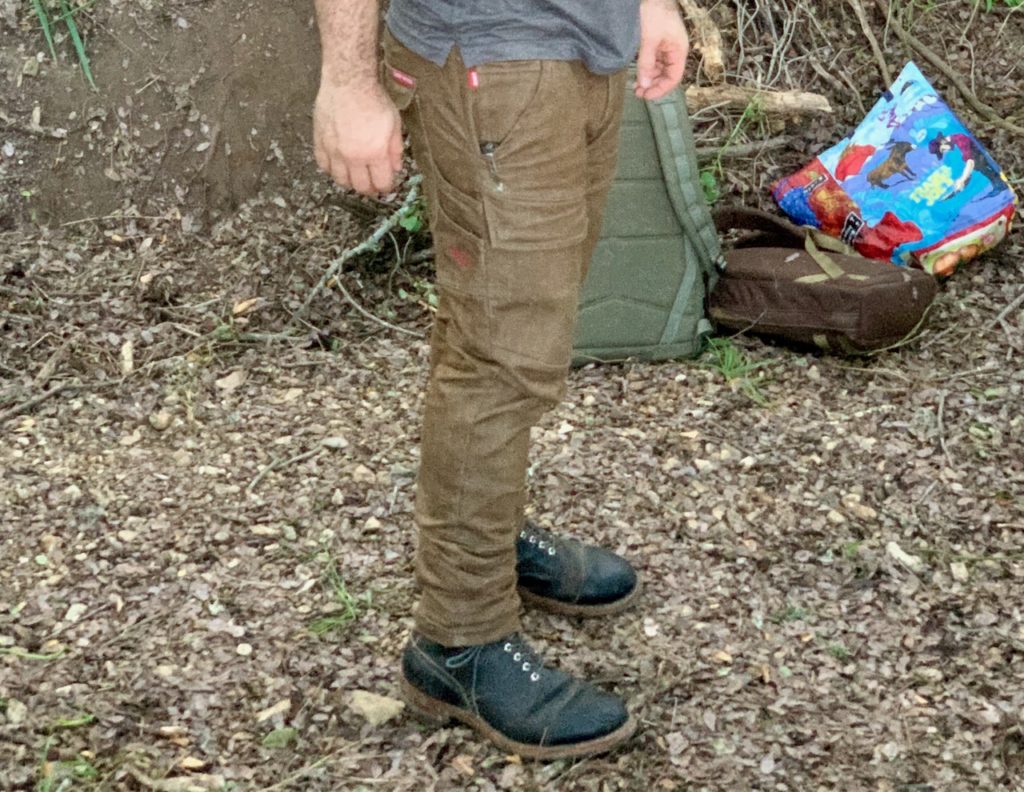
Cycling and motorcycle clothings feature lots of nylon, waxed canvas, and leather for durability and abrasion resistance (in case you eat pavement). The pants will often have gusset crotches and reinforced seams to make sitting and peddling easier.
Outerwear aimed at motorcyclists will often have armor inserts, but you can just use those as extra pockets in daily life and then slide armor in when entering the Thunderdome 🙂
You can find high-quality, prepper-appropriate clothing from brands that either cater to these niches, or that got their start catering to these niches but have since branched out. A lot of better brands in this space are weirdly men-only, with relatively few options for women. So this is one of the harder niches to shop for women’s prepper clothing in.
Some key cyclist clothing makers to check out:
- Outlier: I’m a huge Outlier fan, and have invested considerably in their Strong Dungarees and Slim Dungarees. Their clothes cost an arm and a leg, but you buy it for life. The brand started out aimed at cyclists, but has morphed into a more general-purpose “techwear” brand.
- Duer: Famous for high-quality denim jeans made with a cotton/nylon blend. These are ultra-tough pants, and more niche brands are starting to copy them. This is the original article, though.
- Mission Workshop: Very high-end outdoor and cycling wear, targeted at the urban set. Build quality is great, and the materials used are state-of-the-art.
Motorcycle clothing makers:
- Saint: This is an Australian brand, so shipping is brutal. But I wear their Dyneema-infused chinos and cargo pants daily, because they’re comfortable and completely indestructible. This is clothing-as-motorcycle-armor, and it’s heavy but really good.
- Jane Motorcycles: A niche maker of motorcycle wear, Jane is kind of a Brooklyn “hipster” heritage-type brand. But the attention to materials and quality are off the charts (as are the prices). Snap up what you can from them before they blow up, sell out, and go offshore.
- VKTRE Moto: A really boutique small-batch maker out of L.A., the focus is on advanced, abrasion-resistant fabrics and streetwear friendly styles.
Workwear
Workwear brands like Carhartt and Dickies are staples on construction sites and in shops the world over for a reason: this stuff is very, very good. Especially for the price. People work hard jobs outside in these clothes for years before having to replace them. Miraculously, the brands listed here have managed to avoid the drop in quality that comes with mainstream popularity and large sales volumes.
These garments feature a lot of cotton canvas “duck cloth” that’s extremely tough and can shed more water than other cotton weaves. You’ll also find numerous flame-resistant clothing options from these makers, because many of their customers work around sparks or open flames.
The main downsides to these brands are weight and fit. The clothes are heavy, since they’re optimized for toughness and affordability. The garments also tend to be really roomy, with a bulky fit. For larger bodied preppers, this makes them a great choice. But for average and smaller frames, these clothes will usually swallow you and take up too much room inside of a go-bag backpack.
There are very plentiful women’s clothing options in the workwear space. It shouldn’t be a challenge to find women’s versions of most of the workwear lines and products aimed at men.
Some key workwear brands:
- Carhartt: My dad wore Carhartt, and when I started working at the family radiator shop at 14, I wore it too. All these decades later, people who work long hours in shops and on job sites are still wearing it. I still wear Carhartt around my property for outdoor work.
- Tough Duck: The Canadian answer to Carhartt. Some like it better.
- Walls: Another Carhartt competitor that many favor. I’ve owned and worn Walls for hunting and outdoor work, and really liked it.
Heritage clothing
Heritage clothing is often associated with terms like “hipster,” “lumbersexual,” and so on. Think flannel shirts, trucker jackets, leather boots, and denim. This stuff is popular with urban types who want to give off a rustic vibe. The materials most used in these kinds of clothes — leather, wool, cotton — are natural, durable, and can be repaired and maintained for years or even decades. This makes this category a great place to look for long-term grid-down preps.
Because the “heritage” label is more about the maker, the materials, and the vibe, you can find heritage or heritage-type products in a number of other clothing niches. eg. Filson is a heritage brand that makes hunting and work clothes. This makes it easy to mix and match specific heritage items — like a waxed canvas trucker’s jacket, or some White’s Boots — with clothing from other niches, like motorcycle wear, outdoor wear, or workwear.
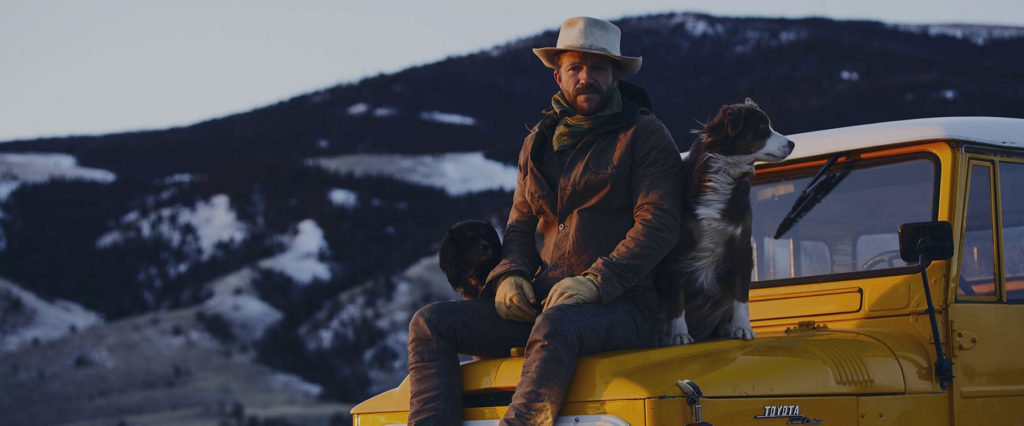
There are three big downsides to going in a heritage direction with your prepping wardrobe:
- The clothes are heavy and not as comfortable as garments made from modern synthetics and blends.
- Quality heritage clothing is quite expensive, and often marked up to the degree that the pure prepping case for even the very best garments is just not there.
- Not a lot of women’s options among the higher end niche makers.
- It’s really easy to get ripped off if you’re not careful.
Regarding the rip-off problem, there are two reasons people pay premium prices for heritage products that are poor quality. First, the target market here is all about style over substance — essentially the polar opposite of the workwear market. There are entire brands — Best Made Co. and Bespoke Post are two common examples — where the products are overpriced, comically impractical junk that’s made to look “rustic.” But apparently people are buying this stuff, because they keep running ads for it.
Second, the label “heritage” is usually more about how long the company has been around. Only certain brands, like Levi’s and Red Wing, are properly termed “heritage” because they’ve been in continuous operation for many decades. Some of these longstanding brands have off-shored the production of their most popular products to Asian factories, but they’re still charging USA-made prices for the goods.
In order to avoid getting ripped off, you can’t just look at brands alone — you have to look at specific garments and find out where they’re made. Filson, for instance, still makes some of its items in the USA, while other parts of its line are outsourced. So if you’re buying their clothes, you have to look at the tags on an item-by-item basis.
Frye Boots is in a similar boat — they’ve outsourced most of their production to China, but you can find special (and extremely overpriced) runs of boots that are American-made to the old standards.
The other way to avoid getting ripped off is to go with newer niche makers who make some clothing in heritage styles. This is actually my preferred way to buy heritage — I just skip the known heritage brands entirely and go with similar goods from smaller-batch makers in the US.
Some key heritage brands:
- L.L. Bean: Despite their popularity, this old-school heritage brand still makes its clothing in the US. Great for everything from outerwear to base layers, with plenty of women’s options.
- Pendleton: This maker of wools and flannels is now outsourcing a lot, so it isn’t quite what it was in the old days. But you can still get quality products from them if you do your homework. Their stuff is pretty marked up, so look for sales.
- White’s Boots: A niche maker of hard-use boots for loggers and wildland firefighters. Expensive, but worth it. A pair of their Bounty Hunters is my “if you only had one” footwear choice..
Some key “heritage” brands (ie. newer, but in that style):
- Nick’s Boots: Founded by a former White’s employee, and considered comparable in quality by most.
- Red Clouds Collective: A newer niche maker of heritage-style clothing. Expensive, but the quality and attention to detail are very high.
- Rogue Territory: Based in LA and more urban, but with a lot of classic styles and materials that will be familiar to anyone into heritage clothes. Extremely high quality products made in smaller batches, and very expensive.
Resources for learning more
There are a few places online where you can learn more about some of the clothing and brands:
- BuyItForLife (BIFL) subreddit: This is a fantastic resource for preppers who want goods that will last in a long-term grid down.
- GoodYearWelt subreddit: Named for a particular type of boot construction, this is the best resource for hard-use footwear. This is very menswear-centric, but you can find women’s wear brands and options discussed, here.
- Techwear subreddit: The folks who frequent this subreddit are into the urban ninja aesthetic. But they have an extreme focus on modern fabrics and construction quality, and you can learn a ton just lurking there.
- Styleforum: This is good for research on specific garments or brands. So if you’re evaluating a particular item, and you want to know about fit/sizing, features, build quality, and so on, a quick search of this forum will often yield a ton of relevant results.
